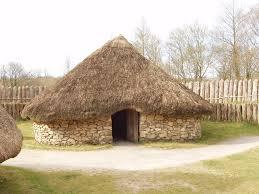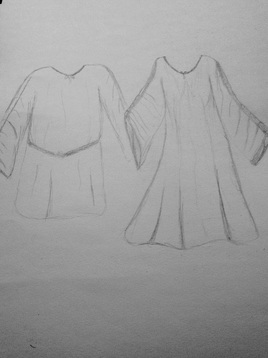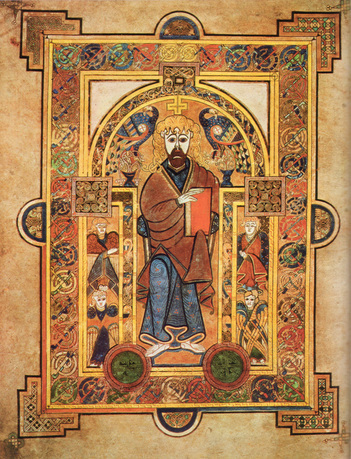The Setting for A Woman of Courage
Today I'm celebrating the release of my latest story, which is set in early medieval Ireland. I thought it might be nice to give you a quick look at Fianna and Connell’s world. A brief Overview of Early Medieval Ireland  Perched on the western edge of Europe and never conquered by the Romans, ninth century Ireland had its own distinct culture. You might be forgiven for thinking the Irish were a primitive people. After all, they had no towns or cities. They lived in clans or túath that occupied ringed hillforts with circular homes of wattle and daub.
Perched on the western edge of Europe and never conquered by the Romans, ninth century Ireland had its own distinct culture. You might be forgiven for thinking the Irish were a primitive people. After all, they had no towns or cities. They lived in clans or túath that occupied ringed hillforts with circular homes of wattle and daub.
 My rendition of the traditional Irish Leine based on my research They had no monetary system; instead their wealth was measured in cattle.
My rendition of the traditional Irish Leine based on my research They had no monetary system; instead their wealth was measured in cattle.
Clothing was basic with both men and women wearing a long dress-like garment called a léine. The woman’s léine reached her ankles, whereas a man’s came to the knees.
But this was a rich culture with a strong tradition of scholarship and literacy, including a Celtic form of Christianity, and a native system of laws known as Brehon law, which recognized divorce and equal rights between genders.
Marriage in ancient Ireland was not regarded in the same way as today. It was a legal contract between clans rather than the unbreakable bond between man and wife. Once a marriage contract was arranged the groom paid a dowry or bride-price to the bride’s father. Each year after the marriage the groom paid a settlement to the bride’s clan. After the first year the bride kept a portion of the payment that added to her wealth. The amount diminished each year until the twenty-first year when it ceased.
 Book of Kells believed to have been created in the 9th century Celtic Christianity didn’t frown on divorce. The Celts were much more practical, concentrating instead on writing the laws governing separation. This could be because a husband never owned his wife. When she married all her property and wealth stayed in her control, and in the event of estrangement she retained her possessions.
Book of Kells believed to have been created in the 9th century Celtic Christianity didn’t frown on divorce. The Celts were much more practical, concentrating instead on writing the laws governing separation. This could be because a husband never owned his wife. When she married all her property and wealth stayed in her control, and in the event of estrangement she retained her possessions.
Although Ireland was a male-dominated society, women were allowed greater freedom, independence, and property rights than in other European societies of the time. Women were able to become poets, healers, and brehons (lawyers). And under the right conditions, with the backing of her male relatives, a woman could become queen of her people, as is the case for Fianna in A Woman of Courage.
 Perched on the western edge of Europe and never conquered by the Romans, ninth century Ireland had its own distinct culture. You might be forgiven for thinking the Irish were a primitive people. After all, they had no towns or cities. They lived in clans or túath that occupied ringed hillforts with circular homes of wattle and daub.
Perched on the western edge of Europe and never conquered by the Romans, ninth century Ireland had its own distinct culture. You might be forgiven for thinking the Irish were a primitive people. After all, they had no towns or cities. They lived in clans or túath that occupied ringed hillforts with circular homes of wattle and daub.  My rendition of the traditional Irish Leine based on my research They had no monetary system; instead their wealth was measured in cattle.
My rendition of the traditional Irish Leine based on my research They had no monetary system; instead their wealth was measured in cattle. Clothing was basic with both men and women wearing a long dress-like garment called a léine. The woman’s léine reached her ankles, whereas a man’s came to the knees.
But this was a rich culture with a strong tradition of scholarship and literacy, including a Celtic form of Christianity, and a native system of laws known as Brehon law, which recognized divorce and equal rights between genders.
Marriage in ancient Ireland was not regarded in the same way as today. It was a legal contract between clans rather than the unbreakable bond between man and wife. Once a marriage contract was arranged the groom paid a dowry or bride-price to the bride’s father. Each year after the marriage the groom paid a settlement to the bride’s clan. After the first year the bride kept a portion of the payment that added to her wealth. The amount diminished each year until the twenty-first year when it ceased.
 Book of Kells believed to have been created in the 9th century Celtic Christianity didn’t frown on divorce. The Celts were much more practical, concentrating instead on writing the laws governing separation. This could be because a husband never owned his wife. When she married all her property and wealth stayed in her control, and in the event of estrangement she retained her possessions.
Book of Kells believed to have been created in the 9th century Celtic Christianity didn’t frown on divorce. The Celts were much more practical, concentrating instead on writing the laws governing separation. This could be because a husband never owned his wife. When she married all her property and wealth stayed in her control, and in the event of estrangement she retained her possessions. Although Ireland was a male-dominated society, women were allowed greater freedom, independence, and property rights than in other European societies of the time. Women were able to become poets, healers, and brehons (lawyers). And under the right conditions, with the backing of her male relatives, a woman could become queen of her people, as is the case for Fianna in A Woman of Courage.
Published on November 13, 2015 02:00
No comments have been added yet.



